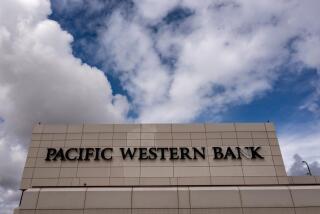Wells Fargo Makes $10.9-Billion Bid for First Interstate : Finances: Hostile takeover attempt could become the biggest bank merger in U.S. history. But analysts say thousands of jobs could be lost as branches close.
In a bold move that would double its size and transform the landscape of California banking, Wells Fargo & Co. Wednesday launched a hostile $10.9-billion takeover bid for First Interstate Bancorp.
The deal could become the biggest bank merger in U.S. history, and it is certainly the largest unsolicited bank bid ever, an audacious action in an industry whose mergers tend to be civil affairs.
If successful, San Francisco-based Wells’ bid would mean that Los Angeles would cease to be headquarters of any major bank. Another Los Angeles banking power, Security Pacific Corp., disappeared from the scene after its 1992 merger with San Francisco-based BankAmerica Corp.
To consumers, it could mean disruption as branches close and accounts are shifted. There would also be a change in climate as Wells, known for its lean, high-tech approach to retail banking, might offer less personal service than some First Interstate customers expect.
Wells officials would not estimate how many workers might be laid off or branches closed, but analysts said thousands of jobs could be lost. Wells has 19,400 workers, nearly all in California; First Interstate has 27,901 employees in 13 Western states.
In Orange County, Wells Fargo employs the equivalent of 1,389 full-time workers at its 55 branches and four regional offices.
Though it’s the last major bank based in Southern California, First Interstate has a smaller presence in Orange County than the San Francisco-based Wells. First Interstate employs the equivalent of 410 full-time workers at its 35 branches and five regional offices.
Another question is what would happen to the 73-story First Interstate World Center--tallest building west of the Mississippi River--that dominates the Downtown Los Angeles skyline.
Wells’ blockbuster offer--valued at $143.125 a share for First Interstate stock, one-third higher than its price a day earlier--puts tremendous pressure on First Interstate’s managers and directors to either negotiate a deal with Wells or find another buyer to top it.
“How can they say no?” asked George M. Salem, a banking analyst with Gerard Klauer Mattison who has been predicting a Wells-First Interstate deal for months.
But Wells is also under pressure.
Its bid comes against a backdrop of rapid--even frenzied--consolidation in the banking industry this year, with more than $50 billion worth of deals announced so far, topped by the pending marriage of New York’s Chemical Banking Corp. and Chase Manhattan Corp., valued at about $11 billion.
Like other large but primarily regional banks, Wells is in danger of getting outstripped in size and outmaneuvered for territory by acquisitive megabanks such as NationsBank Corp. and Banc One Corp. Wells, with $51 billion in assets, is the nation’s 17th largest banking company. First Interstate is No. 14, with assets of $55 billion. Even together they would be far smaller than BankAmerica Corp., with assets of $230 billion.
*
With revenue slowing and competition increasing from mutual funds and other financial service providers that don’t spend as much on branch offices and employees, banks also are being pushed to cut costs.
Wells Fargo estimated that a merger with First Interstate would result in a net $700 million in savings, mainly from shutting branches and laying off workers.
Wednesday’s stunning announcement came about after Paul Hazen, Wells Fargo’s bookish chairman, had approached his counterpart at First Interstate, Chairman William E. B. Siart, a day earlier and surprised him with the merger offer.
As Hazen related it in an interview Wednesday, Siart responded that he wanted six months to consider First Interstate’s “other options,” presumably including finding another merger partner or remaining independent.
“We were very polite and very succinct in expressing our different point of view about the sense of urgency,” Hazen said. “I was going to go forward and I wanted to persist in that desire.”
Early Wednesday, Hazen pulled the trigger, announcing the bid publicly and quickly gathering his officers to explain it in detail to Wall Street analysts and news reporters.
Hazen, 53, and Siart, 48, are “casual friends” in Hazen’s words and have played golf and tennis together. They also share remarkable similarities in their career paths, education, age and style. Both are highly competitive, and both prospered under more flamboyant mentors--former Wells Chairman Carl E. Reichardt and former First Interstate Chairman Joseph J. Pinola.
Nevertheless, Siart’s public response Wednesday was abrupt and cool.
“I am deeply disappointed that Wells Fargo would take this uninvited action,” he said in a statement. Siart added that the company and its directors “have been exploring a wide range of strategic alternatives, of which Wells Fargo is one.”
Siart said First Interstate would consider Wells’ offer and respond “when appropriate.”
Investors, however, reacted to the news ecstatically, pushing First Interstate’s stock up $34.25 a share, to close at $140.25 in trading on the New York Stock Exchange.
Wells Fargo, already the priciest big bank stock in the country, jumped $15.375 to close at $229.
“The shareholders of both companies have voted already,” Wells Fargo President William F. Zuendt said in a press conference with Hazen Wednesday morning at Wells’ San Francisco headquarters.
To be sure, First Interstate is not without options. It is said to have had recent merger overtures from two Minneapolis-based banking firms with multi-state operations, Norwest Corp. and First Bank System Inc.
A combination with a partner from outside the region would not produce the cost savings that Wells envisions but would spare the jobs of thousands of First Interstate workers.
Still, “it’s very hard to say no to a preemptively large offer if you’re a director of a publicly traded company,” said Howard Adler, a bank merger specialist for the law firm of Gibson, Dunn & Crutcher in Washington.
Under the proposal, Wells would pay First Interstate shareholders five-eighths of a share of Wells stock for each of their shares. Based on Wells’ $229 closing price Wednesday, the deal would be worth $143.125 per First Interstate share, or $10.9 billion in all--nearly three times the company’s book value (the difference between its assets and liabilities).
With most recent bank mergers priced closer to 2 or 2 1/2 times book value, analysts said the Wells offer was intended to discourage other potential bidders.
“It’s clearly a knockout bid,” Bert Ely, a banking consultant in Alexandria, Va.
It is uncertain whether the deal would top the pending Chemical-Chase merger as the largest ever. Both transactions involve stock rather than cash, so their values fluctuate with the acquiring companies’ stock prices.
What is certain is that some of America’s best-known investors were millions of dollars richer Wednesday. Berkshire Hathaway Corp., the investment firm of Warren E. Buffett, owns 13.3% of Wells’ stock. Walter Annenberg, founder of TV Guide, owns an 8.8% stake in Wells.
On the other side, the New York leveraged buyout firm of Kohlberg Kravis Roberts & Co. owns a 7.6% stake in First Interstate.
*
Wells may be in the best position to pay a top price for First Interstate for two reasons: First, its stock--the currency being used in this and most other bank deals--has been surging lately. But more important, because Wells’ and First Interstate’s operations overlap to such an extent, no other bank--with the possible exception of Bank of America--could achieve the kind of cost reductions that Wells projects.
Bank of America declined to comment on the Wells announcement Wednesday.
“This acquisition makes the most sense for Wells to do, but that does not mean that somebody else might not try it,” said Denis Lapaige, president of Mackay-Shields Financial, a money-management firm that owns about 1 million First Interstate shares.
Lapaige said he also expects Wells’ offer to increase. “We are not sellers of the stock, even at $140,” he said.
David Berry, research director for the Keefe Bruyette & Woods brokerage, said Wells Fargo’s estimate of $700 million in potential cost savings would be considered inflated for any other bank.
“But since it’s Wells, I’d tend to give them the benefit of the doubt,” he said. “They’re hell on costs.”
Customers of both banks expressed concerns about the service they would receive if the merger takes place. Some said they expect longer lines and a less customer-friendly atmosphere.
“I’m not happy about it. . . . I feel like we’re losing our choices,” said Gloria Carroll, 40, who banks with Wells Fargo. Formerly a customer of Security Pacific and Crocker Bank--which merged with Wells--Carroll says she doesn’t like the trend toward megabanks.
“When you have more choices they’re going to be more customer-friendly,” she said.
Although the two banks are similar in size, customers would also notice a difference in how they operate.
Wells is lauded as one of the country’s most technologically advanced banks, “a pioneer in changing the industry and moving the customer into lower-cost delivery channels,” as one analyst put it Wednesday.
A leader in telephone banking and home banking by computer, Wells was the first big bank to open a site on the Internet. It has also attracted attention with its more than 300 mini-branches in supermarkets across California.
However, consumers used to lots of hand-holding and personal contact with their bankers might not like the Wells approach. First Interstate, while also an aggressive cost-cutter in recent years, has tended to be more old-fashioned.
A merger would almost certainly result in a make-over of First Interstate’s branch system to more closely resemble the high-tech, high-efficiency Wells system.
And that might mean opportunity for other banks, said Gene Galloway, executive vice president for retail banking at Los Angeles-based Sanwa Bank.
*
Times staff writers James Bates, Ealena Callender, Martha Groves, Chris Kraul, James F. Peltz and Stuart Silverstein contributed to this story.
* RELATED STORIES: D1, D5-D7
(BEGIN TEXT OF INFOBOX / INFOGRAPHIC)
Takeover Bid
Here’s how the possible merger of Wells Fargo & Co. and First Interstate Bancorp would affect Orange County:
*--*
Wells First Fargo Interstate Branches Countywide 55 35 Companywide 861 1,133 Employees Countywide 1,389 410 Companywide 19,400 27,901 Deposits Countywide* $2.9 bill. $1.7 bill. Companywide $38.9 bill. $48.2 bill.
*--*
* As of June 30, 1994
Sources: Findley Reports, Wells Fargo Bank, First Interstate Bank. Researched by Dan Margolis.
More to Read
Inside the business of entertainment
The Wide Shot brings you news, analysis and insights on everything from streaming wars to production — and what it all means for the future.
You may occasionally receive promotional content from the Los Angeles Times.










